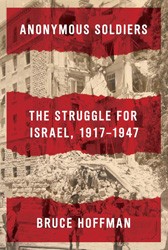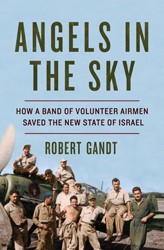By
– October 5, 2011
Jews often think of the Balfour Declaration as a stage in Zionism’s progress between the First Aliyah and the creation of the State of Israel. Historian Jonathan Schneer sees it as an outcome of Great Britain’s secret diplomacy during World War I, which gave rise not only to the Balfour Declaration but also to similar promises to Arab leaders, leading to inevitable conflict between Jews and Palestinians.
Schneer, in fact, devotes the first hundred pages of this book to the negotiations between the British and Grand Sharif Hussein of Mecca. Hussein, who had ambitions of leading a pan-Arab movement, was seen as the key to shifting Arab sympathies away from the Ottoman Empire and its call for jihad against the Entente powers of Britain, France, and Russia. The British cultivated his hopes of ruling an Arab kingdom and encouraged him and his sons to revolt against the Ottomans.
Without Hussein’s knowledge, the British government was simultaneously courting the support of British Zionists with promises of a Jewish homeland in Palestine. This was not an altruistic or idealistic decision. As one of the key players in the Foreign Office wrote, “I do not think it is possible to exaggerate the international power of the Jews.” They imagined that the support of “international Jewish finance” was a critical factor in winning the war, and they wanted to gain that support ahead of Germany and its allies.
These contradictory promises could not both have been kept. Yet as if that weren’t enough, Britain also negotiated a secret understanding in 1916 with France, the Sykes- Picot Agreement. In order to stake its claim to Ottoman territory in the Middle East after the war, Britain promised France some sort of joint rule over Palestine and French sovereignty over territory the Arabs thought would become theirs. What’s more, in the final year of the war, the British offered Ottoman suzerainty over Palestine and other lands to tempt them to make a separate peace with the U.K. and its allies.
Whether this was treachery or Realpolitik is a matter of opinion, but the same geopolitical contention is still with us today, and it is not limited to the Arabs’ sense of betrayal and their resentment of the Jewish state. Turkey’s moves earlier this year to take a greater role in the Arab world bring to mind its former role as the seat of the Muslim caliphate. Its flotilla against Gaza recalls the Ottoman defeat there in 1917 at the hands of General Allenby.
Jonathan Schneer masterfully highlights revealing details within the larger context in his wide-angled view of the region and the Great Powers that contested it. The cloak-and-dagger stories of clandestine meetings in neutral Switzerland might have come straight from an espionage novel. His in-depth history of a critical period explains a great deal about the Middle East today and is constantly fascinating besides.
Those events account for only a few pages in The Land of Blood and Honey, Martin van Creveld’s concise history of Israel, since his task is to condense over a hundred years of events into a short volume. Happily his survey has room for many well-chosen and little-known particulars amid all the major events, dates, and personalities. He calls attention to the Jews of the First Aliyah who chose to wear keffiyehs, the traditional Arab headdress. Haifa, we learn, was bombed by Axis forces during World War II. Ben Gurion was so upset with the newsweekly HaOlam HaZeh that he nearly ordered the security service to arrest its editors.
Van Crefeld also takes pains to capture the texture of everyday life. He describes housewives doing laundry by hand and managing without refrigerators in the 1950’s, and supermarket employees constantly updating price stickers during the inflation of the early 1970’s. He also has an eye for the arresting statistic. Israel has led the world in the number of published papers in computer science per capita, he notes, and it ranks nearly as well in science, physics, and mathematics. The percentage of those who attend the theater in Israel is twice as high as those who watch soccer matches.
Politics, government, economics, and war are the heart of the story, and van Crefeld summarizes the events with maximum clarity and minimal confusion. He is also not shy about making the occasional judgment: he states unequivocally that “Moshe Dayan was the greatest soldier Israel has ever produced.” His directness may be less welcome when he says things like “the ‘liberation’ of women usually comes at the expense of other women.”
Some readers may be distracted by the author’s use of language, starting with the book’s title. His chapters have trite, portentous titles like “The Nightmare Years” and “Tragedy, Triumph, and Struggle.” And he favors a number of archaic usages, referring to Mizrahi Jews as “Orientals,” the city of Lod as Lydda, and the Jezreel Valley as the Plain of Esdraelon, its Greek name. Still, he has produced a highly readable and informative overview of Israel’s eventful history.
Jonathan Schneer, like Martin van Crefeld, is in firm command of his subject, and is particularly adept in his use of primary sources. What’s more, Schneer’s witty narrative voice and his choice descriptions of the leading personalities are reminiscent of Gibbon and Macaulay, following the great British tradition of graceful prose in the service of historical story-telling. The Balfour Declaration is history at its best.
Schneer, in fact, devotes the first hundred pages of this book to the negotiations between the British and Grand Sharif Hussein of Mecca. Hussein, who had ambitions of leading a pan-Arab movement, was seen as the key to shifting Arab sympathies away from the Ottoman Empire and its call for jihad against the Entente powers of Britain, France, and Russia. The British cultivated his hopes of ruling an Arab kingdom and encouraged him and his sons to revolt against the Ottomans.
Without Hussein’s knowledge, the British government was simultaneously courting the support of British Zionists with promises of a Jewish homeland in Palestine. This was not an altruistic or idealistic decision. As one of the key players in the Foreign Office wrote, “I do not think it is possible to exaggerate the international power of the Jews.” They imagined that the support of “international Jewish finance” was a critical factor in winning the war, and they wanted to gain that support ahead of Germany and its allies.
These contradictory promises could not both have been kept. Yet as if that weren’t enough, Britain also negotiated a secret understanding in 1916 with France, the Sykes- Picot Agreement. In order to stake its claim to Ottoman territory in the Middle East after the war, Britain promised France some sort of joint rule over Palestine and French sovereignty over territory the Arabs thought would become theirs. What’s more, in the final year of the war, the British offered Ottoman suzerainty over Palestine and other lands to tempt them to make a separate peace with the U.K. and its allies.
Whether this was treachery or Realpolitik is a matter of opinion, but the same geopolitical contention is still with us today, and it is not limited to the Arabs’ sense of betrayal and their resentment of the Jewish state. Turkey’s moves earlier this year to take a greater role in the Arab world bring to mind its former role as the seat of the Muslim caliphate. Its flotilla against Gaza recalls the Ottoman defeat there in 1917 at the hands of General Allenby.
Jonathan Schneer masterfully highlights revealing details within the larger context in his wide-angled view of the region and the Great Powers that contested it. The cloak-and-dagger stories of clandestine meetings in neutral Switzerland might have come straight from an espionage novel. His in-depth history of a critical period explains a great deal about the Middle East today and is constantly fascinating besides.
Those events account for only a few pages in The Land of Blood and Honey, Martin van Creveld’s concise history of Israel, since his task is to condense over a hundred years of events into a short volume. Happily his survey has room for many well-chosen and little-known particulars amid all the major events, dates, and personalities. He calls attention to the Jews of the First Aliyah who chose to wear keffiyehs, the traditional Arab headdress. Haifa, we learn, was bombed by Axis forces during World War II. Ben Gurion was so upset with the newsweekly HaOlam HaZeh that he nearly ordered the security service to arrest its editors.
Van Crefeld also takes pains to capture the texture of everyday life. He describes housewives doing laundry by hand and managing without refrigerators in the 1950’s, and supermarket employees constantly updating price stickers during the inflation of the early 1970’s. He also has an eye for the arresting statistic. Israel has led the world in the number of published papers in computer science per capita, he notes, and it ranks nearly as well in science, physics, and mathematics. The percentage of those who attend the theater in Israel is twice as high as those who watch soccer matches.
Politics, government, economics, and war are the heart of the story, and van Crefeld summarizes the events with maximum clarity and minimal confusion. He is also not shy about making the occasional judgment: he states unequivocally that “Moshe Dayan was the greatest soldier Israel has ever produced.” His directness may be less welcome when he says things like “the ‘liberation’ of women usually comes at the expense of other women.”
Some readers may be distracted by the author’s use of language, starting with the book’s title. His chapters have trite, portentous titles like “The Nightmare Years” and “Tragedy, Triumph, and Struggle.” And he favors a number of archaic usages, referring to Mizrahi Jews as “Orientals,” the city of Lod as Lydda, and the Jezreel Valley as the Plain of Esdraelon, its Greek name. Still, he has produced a highly readable and informative overview of Israel’s eventful history.
Jonathan Schneer, like Martin van Crefeld, is in firm command of his subject, and is particularly adept in his use of primary sources. What’s more, Schneer’s witty narrative voice and his choice descriptions of the leading personalities are reminiscent of Gibbon and Macaulay, following the great British tradition of graceful prose in the service of historical story-telling. The Balfour Declaration is history at its best.
Additional books featured in this review:
Bob Goldfarb is President Emeritus of Jewish Creativity International.





